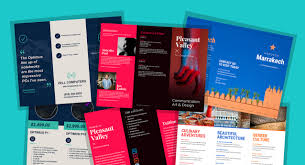Key Takeaways:
- Understand the essential elements of a captivating booklet.
- Learn design tips to make your booklet visually appealing.
- Discover how to distribute your booklet effectively to your target audience.
- Incorporate real-life examples to grasp the concepts better.
Why Booklets Are Effective Tools for Businesses
Due to their versatility and impact, booklets have become a staple in business marketing strategies. Unlike digital ads, booklets offer a tangible experience, allowing businesses to convey detailed information engagingly. With customization options, booklet can be tailored to reflect a brand’s identity and message, creating a memorable impression on the audience. Moreover, booklets provide a sense of value and credibility. They often feel more substantial and permanent than digital content, which needs to be noticed or remembered. This uniqueness makes booklets valuable in creating a lasting impression on potential customers. Additionally, booklets can serve as a keepsake or reference material, ensuring that your business remains top-of-mind long after the initial interaction.
Essential Elements of a Compelling Booklet
An effective booklet needs certain elements to capture and retain the reader’s attention. These elements include an eye-catching cover, an organized layout, clear and concise text, and high-quality images. Each plays a crucial role in making your booklet informative and visually appealing.
- Eye-Catching Cover: The cover is the first thing readers notice. An attractive cover with compelling graphics and a clear title can draw readers in, making them curious about the content. A well-designed cover attracts attention and sets the tone and context for the rest of the booklet, acting as a hook that encourages the reader to dive deeper.
- Organized Layout: A structured design guarantees that your content is straightforward to read. Organize information with headings, subheadings, and bullet points. Break up text effectively to guide the reader through the material. A practical layout prevents overwhelming the reader with large blocks of text and helps them quickly find the information they seek. This structured approach improves readability and enhances the overall user experience, making it more likely that the booklet will be read in its entirety.
- Clear and Concise Text: Avoid information overload by keeping your text clear and concise. Remember to use simple language and focus on the key messages you want to convey to your audience. It’s essential to be clear and avoid using too much jargon or unnecessary words. Keep it simple and direct to ensure your points are well understood.
- High-Quality Images: High-quality images can make your booklet visually appealing and help illustrate your points effectively. Ensure your images are relevant and of high resolution. Poor quality or unrelated photos can detract from the content and reduce the perceived credibility of your booklet. Quality visuals complement and break up the text and can convey complex ideas quickly and clearly, reinforcing the information you present.
Design Tips for Visually Appealing Booklets
The design dramatically influences the reception of your booklet. Here are some design tips to help you create a visually appealing booklet:
- Utilize a constant color palette that represents the identity of your brand. Consistency in color can create a cohesive look and feel, making the booklet more aesthetically pleasing and professional.
- Choose fonts that are easy to read and appropriate for your audience. The right fonts can significantly enhance readability while conveying the right tone and personality for your brand.
- Ensure a good balance of text and images on each page. This balance helps maintain visual interest and keeps the reader engaged throughout the booklet.
- Incorporate white space to avoid clutter and make the content more readable. White space can be just as important as the text and images, as it provides breathing room and aids in the overall layout and design.
Effective Distribution Strategies
After your booklet is completed, it is crucial to distribute it in a way that effectively reaches the intended audience. Consider the following strategies:
- Hand out booklets at trade shows, conferences, and other business events. These settings provide an excellent opportunity to engage directly with potential customers and give them a tangible reminder of your business.
- Mail booklets to potential and existing clients. A well-designed brochure can be memorable when received in the mail as a physical reminder of your business and offerings.
- Make your booklet available for download on your website. Digital downloads can reach a wider audience and provide an easy way for interested parties to access your material conveniently.
- Partner with other businesses to distribute your booklet in stores or offices. Collaboration can significantly boost your reach. This strategy extends your distribution network and introduces your brand to a potentially new customer base.
Successful Use of Booklets
Take, for instance, a local bakery that created a seasonal recipe booklet. They saw increased customer engagement and sales by distributing it at community events and including it in their product deliveries. This example highlights the power of personalized and well-distributed booklets in driving business success. The bakery used the booklet to showcase its expertise and creativity, connecting with its customers personally and encouraging repeat business.
Additionally, the booklet served as a marketing tool that customers could share with friends and family, further extending the bakery’s reach. This real-life example demonstrates the effectiveness of booklets in engaging existing customers and attracting new ones through high-quality, valuable content.
Conclusion
Creating an engaging and effective booklet requires attention to detail and a clear audience understanding. By incorporating the essential elements, utilizing intelligent design tips, and deploying effective distribution strategies, your booklet can be a powerful tool for your business. An effective booklet informs and engages your audience, enhancing your brand’s presence and credibility. Following the tips and best practices outlined above, you can create a booklet that resonates with your audience and leverages its full potential as a powerful marketing tool.
Keep an eye for more news & updates on ChicagoHeading.Com!

